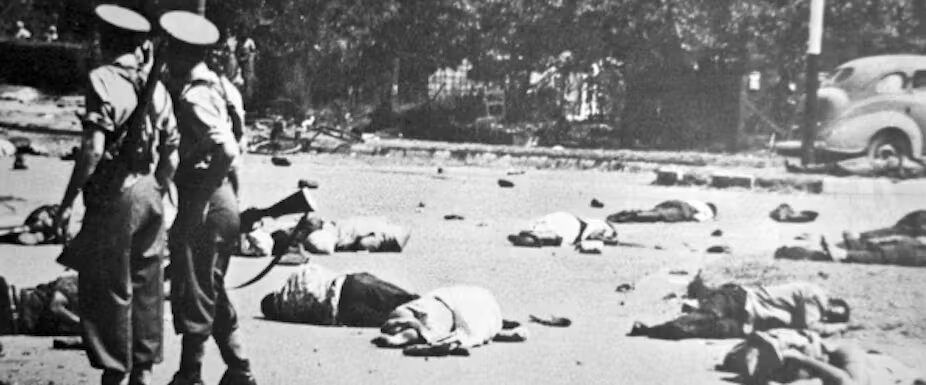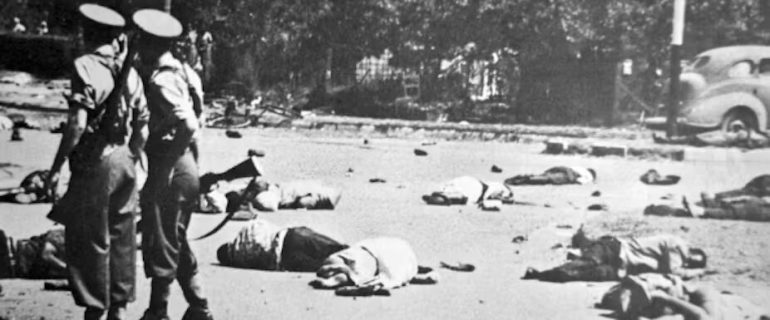Omanyano ovanhu koikundaneki yomalungula kashili paveta, Commisiner Sakaria takunghilile
Veronika Haulenga
Omanyano ovanhu koikundaneki yomalungula kashili paveta, Commisiner Sakaria takunghilile
Veronika Haulenga
Listeners:
Top listeners:
-
play_arrow
Omanyano ovanhu koikundaneki yomalungula kashili paveta, Commisiner Sakaria takunghilile Veronika Haulenga
Sharpeville: new research on 1960 South African massacre shows the number of dead and injured was massively undercounted


Nancy L Clark, Louisiana State University and William H. Worger, University of California, Los Angeles
On 21 March 1960 at 1.40 in the afternoon, apartheid South Africa’s police opened fire on a peaceful crowd of about 4,000 residents of Sharpeville, who were protesting against carrying identity documents that restricted black people’s movement. The police minimised the number of victims by at least one third, and justified the shooting by claiming that the crowd was violent. This shocking story has been thus misrepresented for over 60 years.
Our new research retells the story of Sharpeville, about 70km south of Johannesburg, from the viewpoint of the victims themselves. As experienced historians who have undertaken archival research in South Africa since the 1970s we based our research on interviews with survivors and investigation into government records in both the police archives and the national archives in Pretoria. Our work reveals the true number of victims and the exact role of the police in the massacre.
The Sharpeville Massacre ignited international outrage and the birth of the Anti-Apartheid Movement worldwide. It also led to renewed political protests inside South Africa. These were met with the total suppression of political movements that lasted for 30 years. Despite its historic importance, Sharpeville as a place and a community has remained unknown to the wider public and its residents anonymous. Yet they have a story to tell.
Even though the Truth and Reconciliation Commission chose the 1960 Sharpeville massacre as the formal beginning of its investigation of apartheid crimes, its examination of the massacre itself was perfunctory. Only three witnesses from the community were invited to testify during just part of one day (out of 2,000 witnesses during five years of hearings).
People in Sharpeville believe that the lack of attention to their plight since democracy in 1994 is because the original protest was organised by the rival Pan-Africanist Congress of Azania, not the governing African National Congress (ANC).
Changing the narrative
Based on our research, the new book Voices of Sharpeville traces the long residence of Africans in the greater Sharpeville area, as far as the Cradle of Humankind World Heritage Site 100km north. It also emphasises the crucial industrial importance of the greater Vaal Triangle in which Sharpeville is located, from the 1930s onward.
Our work details the rich culture developed by urban Sharpeville residents in defiance of the attempts of Prime Minister HF Verwoerd’s attempts to control African life.
Using the words of witnesses as recorded from their hospital beds within days of the shooting, and for weeks and months later, the events of 21 March 1960 are recounted in detail, increasing the number of victims to at least 91 dead, and 281 injured. The official police figures first published in 1960 and repeated endlessly ever since were 69 and 180 respectively.
The witness testimony places the responsibility for the shooting squarely with the police.
New evidence
The oral and documentary source material we used was previously off limits to researchers, insufficiently examined, or largely ignored. Access to many records held by the previous apartheid government was absolutely restricted prior to 1994, and since then many of the records have not been properly registered. This makes it challenging for researchers to find important documents.
But with the help of archivists and librarians, we were able to locate rare and even hidden records of Sharpeville and its history, and record the voices of many of the town’s residents.
History of Sharpeville
The first settlement in the Sharpeville area – Top Location – was razed in the 1950s to make space for white people’s businesses and homes. Official records and aerial photographs reveal the previous existence of a large community on the now empty land. There is also an unmarked cemetery where about 3,500 residents were buried between around 1900 and 1938.
By the mid-20th century, apartheid officials began to plan a bigger settlement in the vicinity. Sharpeville and other places like it were designed in the 1950s to segregate Africans away from the cities, which were reserved for white people only.
Sharpeville’s housing construction became a “model” for the ubiquitous four-roomed NE 51/9 houses in black townships throughout the country, none of which they could own outright but rent only.
In almost 300 witness statements taken by the police immediately following the shooting, many of the everyday details of life in Sharpeville were revealed. These statements were recorded immediately after arrest and under oath by the police to determine guilt or innocence against the charges of “public violence and incitement” brought against them. They were also provided voluntarily in 1961 and 1962, also under oath, by survivors and family members to establish a basis for the compensation the victims unsuccessfully requested.
Details of family life – numbers of children, occupations, wages, and health – were recorded, providing a wealth of information about Sharpeville’s residents.
The massacre: Testimony, both from the official 1960 commission of enquiry into the massacre, and the criminal court trial of over 70 Sharpeville residents in 1960-1961, detailed the actions of both the crowd and the police.
The testimony by civilians and police alike, together with the claimants’ statements, provides a minute-by-minute narrative of the day. The testimonies of the residents, including all the Africans who worked for the municipality and as police officers in Sharpeville, unanimously attested to the fact that the crowd gathered peacefully to protest the pass law. According to these witnesses, by the time of the shooting, almost 300 policemen had been moved into the township, including at least 13 white policemen armed with Sten machine guns. There were five Saracen armoured vehicles.
Police testimony makes it clear that the officer in charge gave the order to shoot, with the machine gunners firing directly into the crowd from a distance of no more than 3-5 metres. As one white official noted:
It made me think of a wheat field, where a whirlwind had shaken it.
The crowd was taken utterly by surprise by the police fusillade. Over three quarters of them, dead and injured alike, were shot in the back as they fled.
The victims: Crucial to gaining an accurate understanding of the numbers of victims – their names, families, and injuries – were the autopsy and medical records detailing the exact causes of death and injury for the over 300 victims. These forms and narrative statements, filled out by the hospital physicians who treated the injured and performed autopsies on the dead, prove conclusively that the government under-counted the victims by at least one third.
This new information remained embargoed in police records throughout the apartheid years to 1994. Some of it was finally transferred to the national archives in the late 1990s and early 2000s. It details the injuries.
Remembrance
The people of Sharpeville wonder why the world has not listened to their stories even as they have told them from the day of the shooting to the present.
In 2023, residents were able to use the information uncovered in our research to update the Wall of Names Memorial (which lists the name of every person who gave their life fighting for freedom in South Africa) at Freedom Park in Pretoria to reflect accurately the number of victims killed on 21 March 1960. But still they have received no compensation for their injuries.![]()
Nancy L Clark, Dean and Professor Emeritus, Louisiana State University and William H. Worger, Professor Emeritus of History, University of California, Los Angeles
This article is republished from The Conversation under a Creative Commons license. Read the original article.
Written by: Contributed
Anti-Apartheid Movement Apartheid Freedom Park human rights Nancy L. Clark Pretoria Sharpeville Massacre South African History Truth and Reconciliation Commission Voices of Sharpeville William H. Worger
Similar posts
Windhoek Weather
Most popular

Mbumba signs off new benefits for retired political office bearers

Former FNB employee arrested after defraud pensioner off N$215, 000

Namdia Heist: More questions, lots of confusion

Omuhwahwameki Michael okuunganeka oshikonga shoku patitha oostola dho Rani moshilongo ashihe.

Windhoek woman loses N$60,000 to fraudsters
Copyright 2025 Future Media (Pty) Ltd | Website by Digital Platforms
Tel: +264 83 000 1000 | Email: news@futuremedia.com.na





